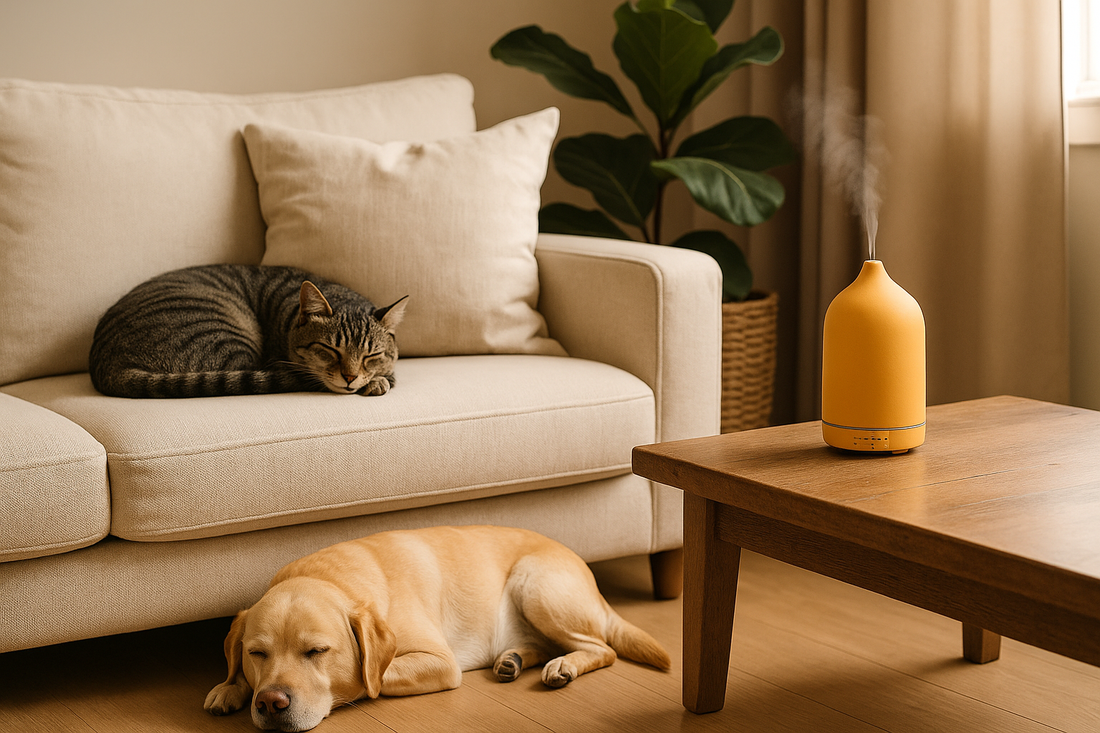
Diffusing Essential Oils Around Animals: Safety, Risks, and Responsible Use
Share
Essential oils offer beautiful therapeutic benefits in the home—but when pets are present, safety becomes paramount. Animals process aromatic compounds differently than humans, and while some essential oils can be diffused safely, others may pose serious risks to their respiratory, neurological, or liver function. Understanding how to use oils responsibly around pets—particularly cats, dogs, and small animals—is essential for any aromatherapy practice in a shared space.
Why Animals Are More Sensitive to Essential Oils
Cats lack certain liver enzymes that are responsible for metabolising many aromatic compounds, especially phenols and monoterpenes. Dogs have a more robust detoxification system than cats, but are still sensitive to strong or prolonged exposure. Small mammals like rabbits, guinea pigs, and birds are extremely vulnerable due to their small size and sensitive respiratory systems.
When essential oils are diffused into the air, animals inhale them just as humans do—yet their capacity to detoxify those compounds is often lower, meaning even small amounts can build up and become toxic. Signs of distress may include drooling, vomiting, lethargy, panting, tremors, or hiding. In birds, respiratory distress may occur rapidly. If any of these symptoms arise, immediately discontinue oil use and ventilate the space.
Essential Oils Commonly Considered Unsafe for Diffusing Around Pets
Tea Tree (Melaleuca alternifolia)
Eucalyptus (especially E. globulus and E. radiata)
Peppermint
Cinnamon Bark or Leaf
Clove
Wintergreen
Pine
Citrus oils (especially cold-pressed lemon, lime, orange, and grapefruit)
Oregano and Thyme (high in phenols)
These oils are especially problematic for cats and small dogs when diffused in poorly ventilated areas or used in high concentrations.
Essential Oils Considered Safer When Used Appropriately
Frankincense (Boswellia carterii)
Lavender (Lavandula angustifolia)
Cedarwood (Virginian or Atlas)
Roman Chamomile (Chamaemelum nobile)
Copaiba (Copaifera officinalis)
Ginger (Zingiber officinale)
Even these oils should be diffused in moderation, with proper ventilation and never in enclosed areas where pets can’t leave if they choose to.
Best Practices for Diffusing Essential Oils Around Pets
Always allow animals access to a scent-free room where they can retreat.
Use passive or intermittent diffusers instead of continuous misting.
Limit diffusion to 10–15 minutes at a time around pets.
Avoid diffusing oils in spaces where pets eat, sleep, or spend prolonged periods.
Keep diffusers, oils, and diluted blends out of reach of animals.
Clean your diffuser regularly to prevent buildup of residues that may affect future diffusions.
Dilution and Concentration Matters
Even when diffusing, essential oil concentration matters. A safe general ratio for water-based diffusers in pet households is 1–2 drops of essential oil per 100ml of water. This helps reduce airborne exposure and ensures a milder aromatic presence.
Always Observe Behaviour
Each animal is unique. What’s tolerated by one pet may distress another. Watch for any changes in behaviour, appetite, energy levels, or breathing, and respond promptly.
If in doubt, consult a veterinarian who is experienced in integrative or holistic care. Some essential oils may be used topically or internally under veterinary guidance, but self-administering oils to pets is not recommended.
At Zurma, we encourage the safe, respectful use of aromatherapy. When shared with awareness and moderation, diffusing essential oils can enhance your space without compromising the health of your animal companions.
Find out more on our Essential Oil Safety Page.
